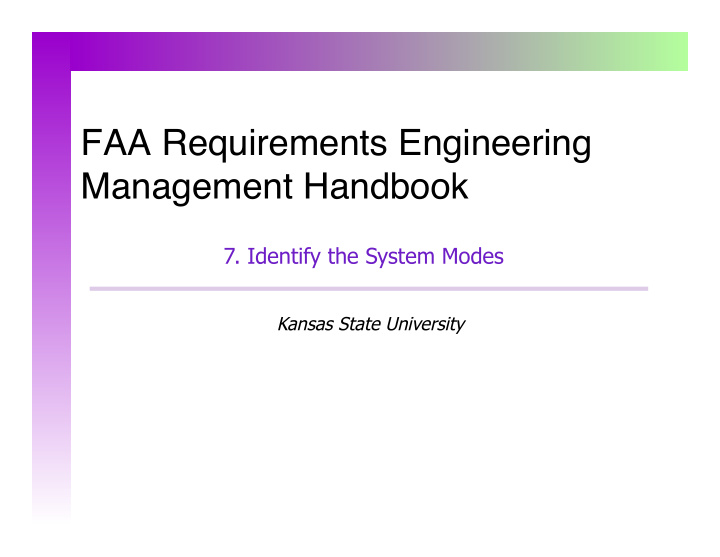



FAA Requirements Engineering Management Handbook � 7. Identify the System Modes Kansas State University
St Steps s in in the REMH EMH Develop the System Overview 1. Identify the System Boundary 2. Develop the Operational Concepts 3. Identify the Environmental Assumptions 4. Develop the Functional Architecture 5. Revise the Architecture to Meet Implementation Constraints 6. Identify System Modes 7. Develop the Detailed Behavior and Performance Requirements 8. Define the Software Requirements 9. 10. Allocate System Requirements to Subsystems 11. Provide Rationale
Arch Archit itect cture re Revisio vision: Goals ls What are we trying to achieve with this step in the requirements engineering process? Identify modes – “macro states” in which system will respond differently to stimuli, i.e., there are discontinuities in externally visible system behavior Avoid mode confusion and associated errors Simplify writing of detailed requirements
Arch Archit itect cture re Revisio vision: Art Artif ifact cts s What artifacts should we produce as a result of this step? List of system modes Mode transition system describing when system will transition between modes based on internal events or external stimuli
6 Revise vise the Arch Archit itect cture re to Me Meet Imp mple leme mentatio ion Const stra rain ints s 7 Identify the System Modes: Modes define disjointed behaviors of the system that are visible to its operators or to other systems. The detailed behavioral and performance system requirements are frequently different for the various system modes. Identification of the system modes is a useful step that simplifies detailed behavioral and performance requirements specification. 7.1 Identify the major system modes before defining the detailed system requirements. 7.2 Define how the system is allowed to transition between modes. 7.3 Introduce modes only to identify the externally visible discontinuities in system behavior. Do not define modes that cannot be inferred from the externally visible behavior of the system.
7.1 Identif ify y Ma Majo jor r Syst System m Mo Modes s A mode is by definition visible to a user Same input causes different response Defined by Leveson as “distinct behaviors of the system” Example: system in which we press a button…behaves one way during system power-up, another way during a self-test, and yet another way during normal operation. A system mode may or may not be explicitly displayed to a system user, but is, by definition, visible, since the system will respond differently to stimuli while in different modes Simplifies system requirements writing E.g., allows the relationship between the monitored and controlled variables to be broken down into smaller pieces for each system mode.
7.2 Defin ine How the Syst System m Tra ransit sitio ions s Be Between Mo Modes s Transition between modes can be specified using a state transition diagram System startup – when self tests have been passed, monitored variables have been successfully sensed, and current temperature status is valid.
7.3 Intro roduce ce Mo Modes s for r Ext Extern rnally lly Visib Visible le Disco iscontin inuit itie ies s Modes should only be defined if they cause externally visible discontinuities Overly complex transition diagrams can be an indication of too many modes Do not define modes that cannot be inferred from the externally visible behavior of the system Don’t include design decisions in mode descriptions
7.3 Intro roduce ce Mo Modes s for r Ext Extern rnally lly Visib Visible le Disco iscontin inuit itie ies s Once modes are identified, we can reference them in detailed requirements – describing how the system should behave in each mode Examples “If the system is in the initialization mode, the controlled variable shall be set to ...” “If the system is in failed mode, the controlled variable shall be set to ...”
Su Summa mmary ry Modes – “macro states” in which system will respond differently to stimuli, i.e., there are discontinuities in externally visible system behavior Identifying modes aids in writing requirements Significant failures have resulted from failing to correctly identify system modes
For r Yo You To Do
Ackn Acknowle ledgeme ments s The material in this lecture is based almost entirely on FAA DOT/FAA/AR-08/32 , Requirements Engineering Management Handbook. David L. Lempia & Steven P. Miller.
Recommend
More recommend